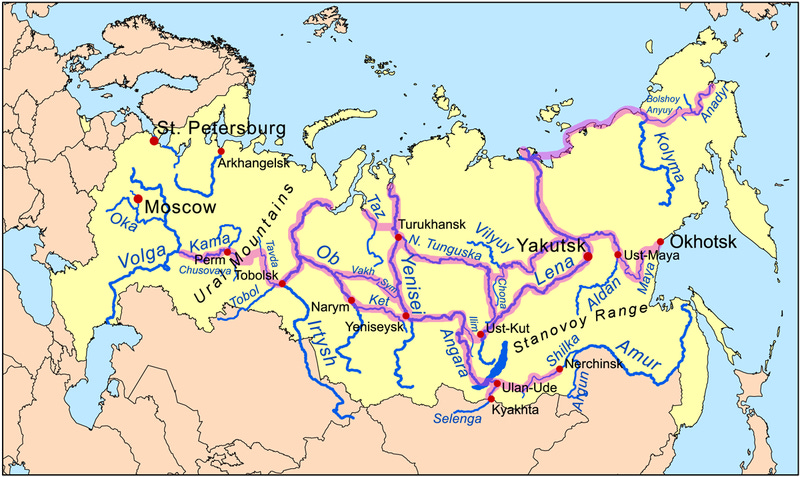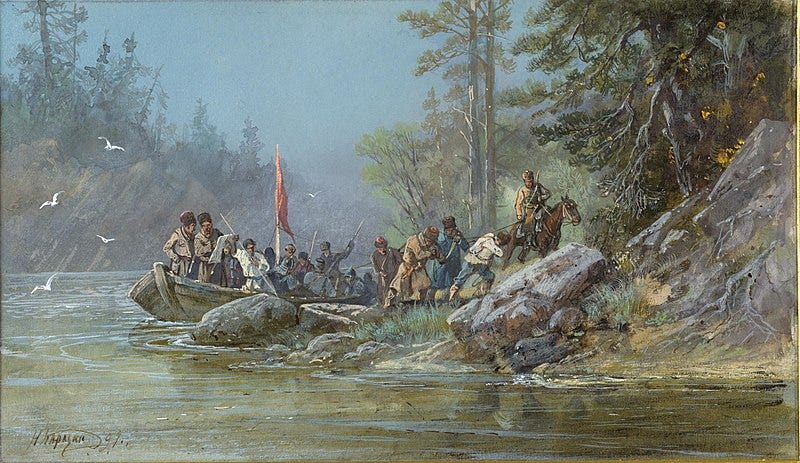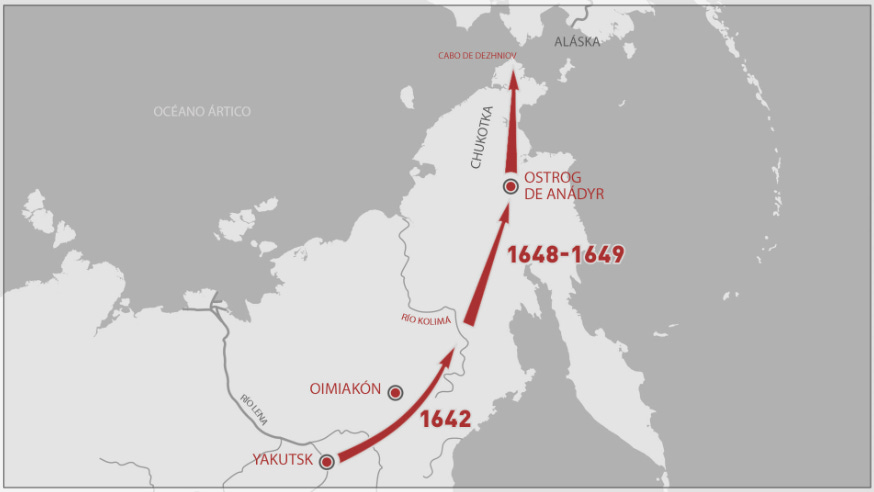The Russian arrival on the Pacific Coast
A brief history of the creation of Russia, its initial expansion and exploration of the Far East until Ivan Moskvitin reached the Pacific Ocean.
In the competition for the largest countries in the world, there are clearly two leagues. On the one hand, we have five countries of relatively similar size: Australia, Canada, Brazil, the United States and China. If I ask you to rank these five countries by land area, probably only the biggest geeks will get it right1. And it's not surprising that it's difficult, as they all have between 7.6 and 9.3 million square kilometres of land area2, more than twice the size of the seventh country in this ranking, India3.
In the other league, there is only one country: Russia. From Kaliningrad to the Bering Strait and from Novaya Zemlya to the Caucasus, Russia covers more latitude and longitude than any other country in the world4. In total, it covers 16.3 million square kilometres5, 11% of all the land on the planet. It is 5.5 times the size of India, 13.5 times the size of South Africa, 32.5 times the size of Spain, and 67 times the size of the United Kingdom.
All this compilation of curious and, surely, irrelevant data for many of you, had the sole purpose of emphasising one idea: Russia is vast. It looks even bigger with the Mercator projection, but even when we compare its size at similar latitudes, the area would stretch from Brazil to Egypt and from there to Zambia.

Today, I am going to tell the simplified story of how Russia conquered the Pacific from its native Europe.
The Principality of Moscow
When the Mongols invaded the lands of Kievan Rus, Moscow was insignificant. So much so that in 1204, after the break-up of Kievan Rus, it was nothing more than a small town within the Principality of Vladimir-Suzdal. During the first third of the 13th century, the lands were attacked time and time again, but Moscow had the advantage of being located in a wooded area that was difficult to access. This allowed it to prosper more than Vladimir, the capital city. In 1238, Mongol pressure finally wiped out the Principality of Vladimir-Suzdal, dividing it into eleven smaller principalities.
One of these principalities was Moscow, which gradually gained power in the area until it established itself as one of the three most important principalities, along with Nizhny Novgorod and Tver. It was only a matter of time before Moscow expanded its territory to become one of the main powers in the region by the middle of the 15th century.

Undoubtedly, the succession of ambitious rulers was key to the growth of the Principality of Moscow, but its great geographical position cannot be overlooked. We have already seen that the forests served as a defence against attacks by Mongol hordes, but the many rivers that crossed the area also allowed navigation across the plains, allowing fast travel times. The trade network stretched from the Baltic Sea to the Caspian Sea, bringing prosperity to all the territories that were conquered.
Ivan III, the Great, came to power in 1462. All the previous princes, even though they did not have real power over the whole of ancient Kievan Rus, called themselves legitimate heirs. Ivan III was not satisfied with this and forced the lesser leaders to recognise him as ruler of the entire territory. Later, he succeeded in annexing the Principality of Rostov (1474), the Republic of Novgorod (1478) and the Principality of Tver (1485). His son, Basil III, completed the task and the Principality of Moscow came to control almost all of what had once been Kievan Rus.

Ivan IV, known as Ivan the Terrible, came to power in 1533 at the age of only three. During the early years, the principality was ruled by his mother, who maintained stability and fought internally to keep her son in power. When he came of age in 1547, he took the power that was rightfully his and also crowned himself Tsar of All Russia, thus ending the Principality of Moscow and beginning the Tsardom of Russia. Without wasting any time, he continued the expansionist policy of his grandfather. He took control of the many hordes that until then had inhabited western Russia, which allowed him to cover the entire length of the Volga River and finally reach the Caspian Sea.
Seeking a route through Siberia
After the death of Ivan IV, Russia gradually entered what would be its first major crisis. His son, Theodore I, had many problems governing and maintaining a state whose size was only comparable to that of the Ottoman Empire. The Time of Troubles began when Theodore I died without an heir in 1598 and ended with the Romanov dynasty coming to power in 1613.
For a quarter of a century, the Russian Tsardom had focused on sorting out its internal issues and defending itself from attacks by the Polish-Lithuanian Commonwealth. That changed in 1613 with Michael I, who resumed Russia's expansion. At a time when much of Europe was colonising America, Michael I chose to take the opposite path and look to the far east of Asia.
![r/Map_Porn - Russian expansion into Siberia (16th and 17th century) [835 × 468] r/Map_Porn - Russian expansion into Siberia (16th and 17th century) [835 × 468]](https://substackcdn.com/image/fetch/$s_!X5V5!,w_1456,c_limit,f_auto,q_auto:good,fl_progressive:steep/https%3A%2F%2Fsubstack-post-media.s3.amazonaws.com%2Fpublic%2Fimages%2F217251f3-b057-465f-9a6f-8ddb8f2ee08f_640x358.jpeg)
Unlike the previous Russian expansion, which focused on conquering nearby territories, the 17th century began with the exploration of vast Siberia. More than 4,500 kilometres separated Perm and Ufa6, the two major cities in the east, from the Pacific coast. In between lay the great plains of Western Siberia, the Central Siberian Plateau and the multiple mountain ranges near the coast. All this with an inhospitable climate and very few previous settlements.
Over the years, several explorers ventured into the vast lands of taiga and steppe and established the first trading posts. This made it easier to obtain resources and advance much more quickly. Once again, rivers were key to this progress. Siberia is crossed by three major rivers, the Ob, the Yenisei, and the Lena. Between them and their tributaries, they cover much of the entire territory, minimizing the distances to travel on foot through these inhospitable lands.

The trading posts that were established at key points soon grew into important towns and cities. Narym, on the eastern side of the Ob River, was founded in 1596. Yeniseisk, on the Yenisei River, was established in 1619. Ust-Kut, on the upper Lena River, was established in 1631, and a year later, Yakutsk was founded in the middle of the Lena River. Thus, without conquering the entire territory, Russia soon found itself on the Pacific coast.
The expedition of Ivan Moskvitin
In 1636, a figure as iconic in Russian history as Christopher Columbus in Western European history emerged: Ivan Moskvitin. Commanded by Cossack Dmitri Kopylov, in 1636, Moskvitin arrived in Yakutsk with 53 other men. The objective of their mission was to find a way to the sea, for which they travelled up the Aldan River, a tributary of the Lena, and established a fort in the upper reaches. They were 250 kilometres7 from Yakutsk and 100 kilometres8 from Ust-Maya.

They stayed for a while in this new fort, which they called Butalsky, to talk to the local population and plan their next steps. According to the story, a shaman told them about the Shirkol River, which had some settlements where grain was grown, cattle were raised and, in addition, there were silver deposits. Kopylov, blinded by the prospect of wealth, sent Moskvitin with 40 Cossacks to find the silver.
Ivan Moskvitin travelled down the Aldan River until he reached Ust-Maya, where he began to travel eastwards up the Maya River. Once they reached its source, and after making several journeys on foot due to the impossibility of navigating the river, they crossed the Dzhugdzhur Mountains and came across the Ulya River. From there, they descended and reached its mouth in August 1639, becoming the first Russians to reach the Pacific Ocean9.

In the following years, multiple expeditions were sent to explore the newly discovered coast. Between 1642 and 1644, the Cossacks reached the Amur River, and the first large settlement was established by Ivan Moskvitin in 1647, 65 kilometres10 north of the mouth of the Ulya River, in the city of Okhotsk. The end of the Bering Strait was reached just one year later, in 1648, when explorer Semyon Dezhnev became the first European to sail its waters11.

The fact that explorers reached the easternmost point of Asia was an important step for Russia, but this was only the beginning of a long period of colonisation. It is one thing to have navigated all the rivers of Siberia, but quite another to establish a firm and lasting power in which the country could benefit from this vast territory.
Here's the order, for those who are curious: China, the United States, Canada, Brazil, and Australia. And yes, the question is tricky, as quite often the number includes ocean area, in which case Canada wins. Would you have got it right?
Between 2.9 and 3.6 million square miles.
India has 2.9 million square kilometres (1.15 million square miles). It is closely followed by Argentina and Kazakhstan.
If you don't count the Arctic islands, Brazil covers more latitude than Russia. It wins by a hair.
6.3 million square miles.
2800 miles.
155 miles.
62 miles.
Specifically, they reached the Sea of Okhotsk.
40 miles.
The strait was named by Vitus Bering, who rediscovered it 80 years later and, for many years, took all the credit.



Love this. I really felt myself exploring that wild, unknown, and unfathomable East Russia.